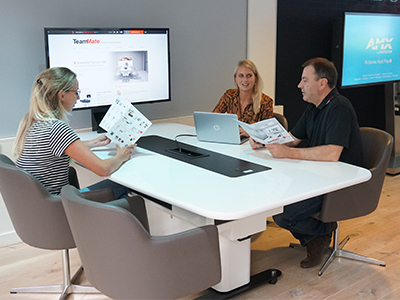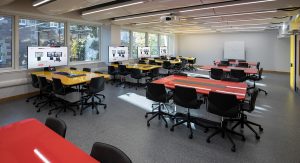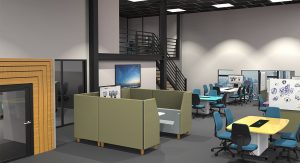
What are the benefits of having a flexible space?
Waber, Mangnolfi and Lindsay (2014) state that creating collisions – chance encounters and unplanned interactions between knowledge workers, both inside and outside the organisation – improves performance (p.3). It is these face to face interactions that are the most important activities to increase productivity and thus collaboration. To get to that point, these spaces must adopt both the right furniture and technology to facilitate these interactions.
Waber, Mangnolfi and Lindsay (2014) go further to explain higher engagement is typically accomplished not with open social space but with tight, walled-off workstations and adjacent spaces for small group collaboration and interaction (p.5). These types of flexible ‘collision zones’ allow users to claim spaces and shape them allowing idea sharing and collaboration.
What makes furniture ‘flexible’?
Our definition of flexible furniture simply means: Being able to adapt to changes, due to user demand, environment or pedagogy. TeamMate ensures each product designed is functional, durable and flexible. Our design team think about the space and what its demands are. As a result, most of our furniture is self-contained and mobile, with easy access to quickly unplug, enabling you to take the meeting or workstation with you. These specialist roomware solutions allow users to create these adhoc zones enabling more collisions and interactions, thus increasing workspace productivity and collaboration. What’s the best thing about it? If it isn’t working, you can change it.
How can I create a flexible space?
An example how flexible furniture can benefit a workspace can be seen with TeamMate WorksZone Collaboration Tables. These tables were installed in the University of Dundee’s Library as part of a flexible learning zone. Each table can be maneuvered, folded and relocated within the room allowing for changes to the layout and ultimately the functionality of the room.

The video can be seen here: https://www.youtube.com/watch?v=F2JHDO_0_v0&t=7s.
TeamMate’s flexible furniture is not only used just for Higher Education, other versatile products when combined together, can be utilised throughout office and breakout spaces to create these ‘collision zones’.


If you want more information or help to creating flexible workspaces then please contact email us at info@teammateworld.com or call +44 (0) 1491823739
References:
- Marquardt, C., Veitch, J. and Charles, K. (2002). Environmental satisfaction with open-plan office furniture design and layout. Ottawa, Ont.: Institute for Research in Construction.
- Waber, B., Magnolfi, J. and Lindsay, G. (2014). Workspaces that move people. Harvard business review. Accessed 08.05.2019.
